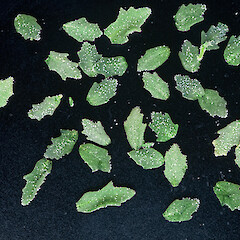Atriplex hollowayi
Common name
Holloway’s crystalwort
Synonyms
None
Family
Amaranthaceae
Flora category
Vascular – Native
Endemic taxon
Yes
Endemic genus
No
Endemic family
No
Structural class
Herbs - Dicotyledons other than Composites
NVS code
The National Vegetation Survey (NVS) Databank is a physical archive and electronic databank containing records of over 94,000 vegetation survey plots - including data from over 19,000 permanent plots. NVS maintains a standard set of species code abbreviations that correspond to standard scientific plant names from the Ngä Tipu o Aotearoa - New Zealand Plants database.
ATRHOL
Chromosome number
2n = 18
Current conservation status
The conservation status of all known New Zealand vascular plant taxa at the rank of species and below were reassessed in 2017 using the New Zealand Threat Classification System (NZTCS) – more information about this can be found on the NZTCS website. This report includes a statistical summary and brief notes on changes since 2012 and replaces all previous NZTCS lists for vascular plants.
Please note, threat classifications are often suggested by authors when publications fall between NZTCS assessment periods – an interim threat classification status has not been assessed by the NZTCS panel.
- Conservation status of New Zealand indigenous vascular plants, 2017 . 2018. Peter J. de Lange, Jeremy R. Rolfe, John W. Barkla, Shannel P. Courtney, Paul D. Champion, Leon R. Perrie, Sarah M. Beadel, Kerry A. Ford, Ilse Breitwieser, Ines Schönberger, Rowan Hindmarsh-Walls, Peter B. Heenan and Kate Ladley. Department of Conservation. Source: NZTCS and licensed by DOC for reuse under the Creative Commons Attribution 4.0 International licence.
2017 | Threatened – Nationally Critical | Qualifiers: CD, EF, OL
Previous conservation statuses
2012 | Threatened – Nationally Critical | Qualifiers: CD, EF, OL
2009 | Threatened – Nationally Vulnerable | Qualifiers: CD, EF, Inc, OL
2004 | Threatened – Nationally Critical
Distribution
Endemic. North Island, formerly recorded from Te Paki south and east to Hicks Bay, including Mayor (Tuhua) Island, with a disjunct southerly gathering made by Thomas Kirk in the 1800s from Lyall Bay, Wellington. Now known naturally only from Waikuku and Whareana Beaches, on the eastern side of Te Paki.
Habitat
Sandy Beaches, at or just above the high water tide mark. Usually found at or in the vicinity of a fresh water stream draining across a beach
Detailed description
Annual, succulent, densely branched herb, forming circular 0.8 × 1.2 m mounds on sandy beaches just above mean annual high water tide mark. All exposed parts copiously covered in fine, sugar-like, deciduous, spherical, glistening, ball-like papillae. Branches 10–50 mm long, succulent, creamy yellow, rooting at nodes. Stems pale yellow. Leaves 2–12 × 1–6 mm, grey-green, margins distinctly but irregularly toothed. Plants monoecious. Male flowers axillary, in clusters of 2–4, rarely single; perianth lobes 5, green or pale-cream, 0.8–1 mm, elliptic-oblong; stamens 5, anthers yellow; female flowers minute, 0.8–1.2 mm, shortly stipitate, solitary or paired in leaf-axils. Perianth absent, bracteolea fused for ½ length, lips triangular, obtuse, laciniate, fimbriate to entire; styles 2 not connate; stigmas 2, white, 0.7–1 mm. Fruits 2.8–4.0 × 1.5–2.3, straw-yellow, urceolate, papery. Seed circular, convexm 0.9–2 mm diam., chestnut-brown maturing purple-brown.
Similar taxa
Atriplex billardierei (Moq.) Hook.f., which can be distinguished by its smooth margined leaves, fused, paired stigma, larger fruits and seeds. A. billardierei appears to have never grown in A. hollowayi habitats, and was historically known in New Zealand only from Southland, Stewart Island and Chatham Island sand beaches. Currently it is only known in New Zealand from the Chatham Islands, where it is seasonally abundant.
Flowering
October - February
Flower colours
Cream, Green
Fruiting
December–April
Propagation technique
Easily grown from seed that has first been soaked in fresh water. Can be grown from softwood cuttings early in growing season.
Threats
At risk from trampling and/or browsing by livestock and palatable to most herbivores. There is some historical evidence suggesting that some of this species decline was caused by botanists collecting whole plants—which to an annual species can be a serious threat. Holloway’s crystalwort is also threatened by competition from other introduced strand plants, summer cyclonic storms, human beach users—especially from the ever increasing use of all-terrain vehicles on sand beaches.
Etymology
atriplex: From an ancient Latin name whose derivation is uncertain, but a possible explanation is the name comes from the Greek a- ‘without’ and traphein ‘nourishment’ because many of these species grow in arid desert soils
Where To Buy
Not commericially available.
Cultural Use/Importance
Considerable conservation effort has been undertaken by the Department of Conservation following a recovery plan written specifically for this species in 2001. As a result Holloway’s crystalwort has been successfully managed back from the brink of extinction. Plans are underway to reintroduce it to several more southerly locations that fit within its historic range.
Attribution
Description based on de Lange et al. (2000).
References and further reading
de Lange, P.J. ; Norton, D.A.; Crowcroft, G.M. 2000: Taxonomy, ecology, and conservation of Atriplex billardierei and A. hollowayi sp. nov. (Chenopodiaceae) in Australasia. New Zealand Journal of Botany 38: 551–567.
Thorsen, M. J.; Dickinson, K. J. M.; Seddon, P. J. 2009: Seed dispersal systems in the New Zealand flora. Perspectives in Plant Ecology, Evolution and Systematics 11(4): 285–309.
NZPCN Fact Sheet citation
Please cite as: de Lange, P.J. (Year at time of access): Atriplex hollowayi Fact Sheet (content continuously updated). New Zealand Plant Conservation Network. https://www.nzpcn.org.nz/flora/species/atriplex-hollowayi/ (Date website was queried)






